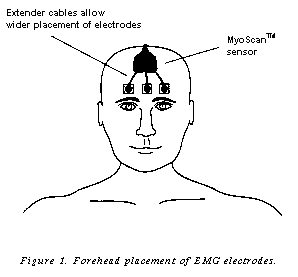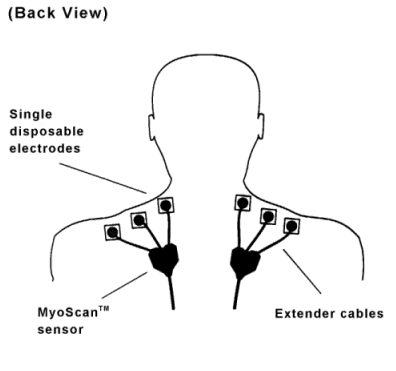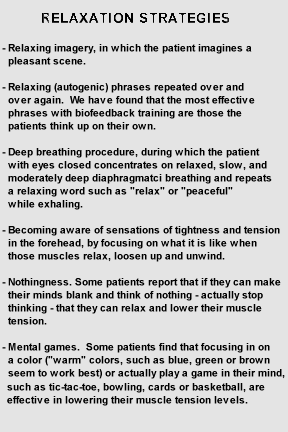Introduction
Headache is the most common pain complaint(11) and the most frequent medical problem seen in medical clinics(7). Most experts(3) believe that the majority of headaches are muscle tension-type. Community-based epidemiological studies have found that 14% of men and 29% of women have had headaches either every few days or headaches which significantly bothered them(9).
Tension headache is generally described as a bilateral dull ache, pressure or cap-like pain that is usually located in the forehead, neck and shoulder regions. The headache typically occurs from two to seven days a week and can last from one hour to all day; a small proportion of tension headache sufferers have continuous headache. Migraine headache, on the other hand, is described as a unilateral pain, generally accompanied with nausea and vomiting, with the pain characterized as throbbing or pulsating. Clinicians who deal with headache patients should use a standardized set of inclusion and exclusion criteria for diagnosis such as specified by the Ad Hoc Committee on the Classification of Headache(1) or the newer Ad Hoc Committee of the International Headache Society(2).
Treatment of Chronic Tension Headache
Behavioral treatments for chronic tension headache have been found to be as effective as pharmacological interventions(8). Although nearly all of the headache literature treats biofeedback and relaxation therapy as separate interventions, most clinicians combine both procedures when treating their tension headache patients.
A study by Holroyd and his colleagues(10), detected no significant difference between subjects who trained to increase or decrease their muscle tension levels; high success feedback groups showed substantially greater improvements in headache activity (53%) than low success groups (26%). This study demonstrated the importance that cognitive mediating factors such as perceived success and self efficacy play in biofeedback training, and the enhanced awareness of ones level of muscle tension during non-biofeedback periods. Thus, the emphasis on biofeedback training with tension headache should focus on skill acquisition and the therapist-patient relationship.
EMG Biofeedback Training
Initially, place the two active sensors approximately in the center of the forehead in line with the pupil of the respective eye. The reference (ground) sensor is placed between the two active sensors (figure 1). We recommend the use of disposable EMG sensors to insure against infection. A reading of less than 2 microvolts generally indicates a fairly relaxed muscle group. If the level starts off and remains low even during stress provoking imagery or discussion, or after the patient has gone through an adequate course of forehead EMG biofeedback and little change in headache activity is noted, advance to the shoulder and neck regions (figure 2). Palpation for muscular tenderness may also be used in the selection of electrode placement sights.
To decrease patient anxiety, refer to the electrodes as sensors, and indicate that EMG only senses electrical activity and does not send current through the body.
Settings on the MyoTrac(TM):
- Set the OFF/CONT/THR switch to continuous
- Set the gain switch to x10, or to x1 if the muscle activity is less than 10 uV.
- Set the threshold setting so that the bargraph reading is near the yellow LED.
- Set internal switches to OFF/OFF/ABV/WIDE
- For clinical use, a computerized EMG system such as the MyoDac2(TM), MyoTrac2(TM), ProComp(TM) or FlexComp/DSP(TM) provides either bargraph or polygraph displays, as well as full database functions which allow the storage of patient information and session data.
Initial Session Strategies
We say something like this: "Its traditionally been assumed that the type of headache you have - tension headache - is caused by very high levels of muscle tension in your forehead, neck and shoulder areas. These muscles have been tense for a long time. Through biofeedback training, you will learn to both be aware of and decrease your muscle tension levels at any time. When you do this, its hoped that you will get a decrease in your headaches."
We next give the patient a number of possible strategies to choose from. We emphasize that learning the biofeedback response is purely an idiosyncratic process and that what works for others may not work for them. We customarily describe 6 possible biofeedback strategies outlined in Table 1 (figure 3).
In the first session, we usually tell the patient to pick only one strategy and stick with it the entire session. We keep the initial session short - a 3-5 min. adaptation period (Just sit quietly with your eyes closed) and a maximum of 12 min. of biofeedback. (In latter sessions, we increase the biofeedback portion to a maximum of 25 min.) We emphasize that learning to relax muscles at will can be a difficult response to learn and that it may take some time before they can lower their forehead muscle tension reliably; we tell them not to get discouraged if they cannot control their EMG levels immediately. We instruct the patients to let the response occur rather than make it occur, to be passive rather than try to force their forehead muscles to relax. We let them choose which type of visual and auditory feedback they like. At the end of the biofeedback session when the sensors are removed and the sessions data is saved, we inquire as to which strategy was employed and the patients perception as to how effective it was. We also get a self report of relaxation, muscle tension and pain levels on a 1-10 scale prior to and following the session. If using a computer, we review the actual minute by minute printout of the data with the patient. Throughout this review we attempt to impart to the patient the most positive feeling of success gained, based on the realities of the sessions data. The number of sessions may run from 10 to as many as 24.






